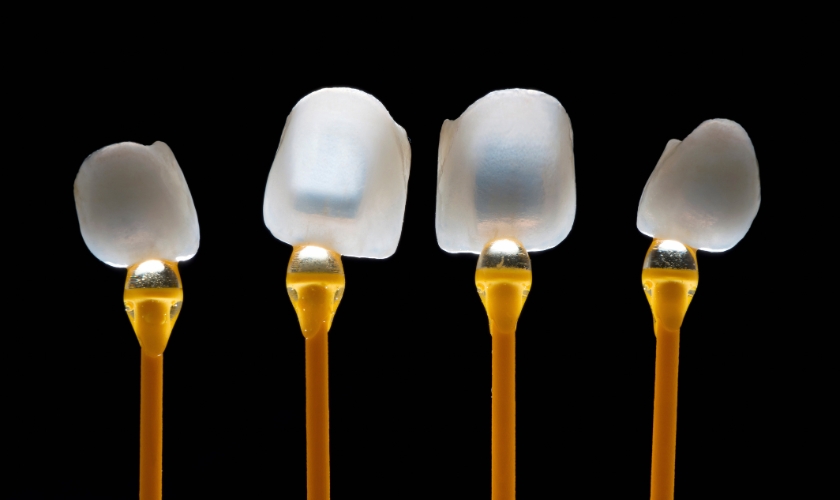Porcelain vs. Composite Veneers: Which One is Right for You?

A captivating smile can light up a room and lift everyone’s spirit. Dental veneers have become a popular solution for those seeking to enhance their smiles. Many individuals consider veneers to address dental imperfections. However, choosing between porcelain and composite veneers requires careful consideration. This guide delves into the differences, benefits, and potential drawbacks of each option, helping you make an informed decision.
What Are Porcelain Veneers?
Porcelain veneers are crafted from high-quality ceramic materials. They mimic the translucency and texture of natural teeth, providing a lifelike appearance. Known for their durability, porcelain veneers can last over a decade with proper care. They resist stains effectively, maintaining their brightness over time. However, the process involves removing a thin layer of enamel, making it irreversible. Additionally, porcelain veneers are typically more expensive than composite options.
What Are Composite Veneers?
Composite veneers are made from resin materials applied directly to the tooth surface. This allows for same-day application, offering immediate results. They are generally more affordable than porcelain veneers. However, composite veneers are less durable, lasting around 5 to 7 years. They are also more prone to staining and may require more maintenance. The procedure is minimally invasive and often reversible, preserving more of the natural tooth structure.
Aesthetic Considerations
Porcelain veneers offer a natural and translucent appearance, closely resembling real teeth. They reflect light similarly to enamel, providing a seamless look. Composite veneers, while customizable, may lack the same depth of color and translucency. Over time, composites might discolor, especially for individuals who consume staining substances like coffee or tobacco.
Durability and Longevity
Porcelain veneers are renowned for their strength and longevity. With proper care, they can last 10 to 15 years or longer. Their resistance to staining ensures they maintain their aesthetic appeal. Composite veneers, being less durable, typically last between 5 to 7 years. They are more susceptible to chipping and staining, necessitating earlier replacement or repair.
Procedure and Time Investment
The process for porcelain veneers usually requires multiple visits. Initially, the dentist prepares the teeth and takes impressions. These impressions are sent to a lab where the veneers are fabricated, which can take a week or longer. Once ready, they are bonded to the teeth. Composite veneers, conversely, are applied directly to the teeth in a single visit. The dentist sculpts the resin material, hardens it with a curing light, and polishes it for a natural finish.
Cost Implications
Cost is a significant factor for many patients. Porcelain veneers are generally more expensive, reflecting the material cost and laboratory fabrication. Composite veneers are more budget-friendly, offering a cost-effective solution for minor cosmetic concerns. However, considering their shorter lifespan, potential cumulative costs over time should be evaluated.
Maintenance and Care
Both types of veneers require diligent oral hygiene practices. Regular brushing, flossing, and dental check-ups are essential. Porcelain veneers’ stain resistance means fewer dietary restrictions. Composite veneers may necessitate avoiding or limiting staining foods and beverages to maintain their appearance. Additionally, wearing a nightguard can protect veneers from grinding or clenching during sleep.
Making the Right Choice for You
Deciding between porcelain vs. composite veneers depends on individual needs, budget, and desired outcomes. For those seeking a long-term solution with superior aesthetics and durability, porcelain veneers may be the preferred choice. If affordability and a less invasive procedure are priorities, composite veneers could be more suitable. Consulting with a qualified cosmetic dentist in Rocklin can provide personalized insights tailored to your specific situation.
Potential Risks and Considerations
While veneers offer significant cosmetic benefits, it’s crucial to be aware of potential risks. Some individuals may experience tooth sensitivity after the procedure. Improper application can lead to issues like misalignment or gum irritation. Choosing an experienced dentist reduces these risks. Additionally, veneers are not reversible; once applied, they require maintenance and eventual replacement.
Enhancing your smile with veneers is a personal decision that involves weighing various factors. Understanding the differences between porcelain and composite veneers is essential in making an informed choice. Consider your aesthetic goals, budget, and the long-term implications of each option. Consult with a trusted dental professional in Meadow Vista to explore the best path to achieving the radiant smile you desire.




